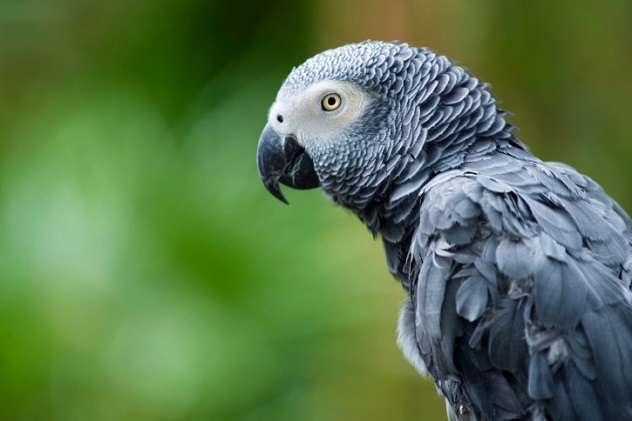 Mysteries
Mysteries  Mysteries
Mysteries  History
History 10 Surprising Stories About the Texas Rangers
 Humans
Humans 10 Philosophers Who Were Driven Mad by Their Own Theories
 Miscellaneous
Miscellaneous 10 Video-Game-Worthy Weapons and Armors from History
 Weird Stuff
Weird Stuff 10 Psychics Who Accurately Predicted Wartime Events
 The Arts
The Arts 10 Pieces of Art Inspired by a Broken Heart
 Health
Health 10 Science Fiction-Sounding New Medical Treatments
 History
History 10 Surprising Facts About the Father of Submarine Warfare
 Space
Space Ten Astonishing New Insights into Alien Worlds
 Weird Stuff
Weird Stuff 10 Bizarre Summer Solstice Rituals Still Practiced Today
 Mysteries
Mysteries Top 10 Haunting Facts About the Ghost Ship MV Alta
 History
History 10 Surprising Stories About the Texas Rangers
 Humans
Humans 10 Philosophers Who Were Driven Mad by Their Own Theories
Who's Behind Listverse?

Jamie Frater
Head Editor
Jamie founded Listverse due to an insatiable desire to share fascinating, obscure, and bizarre facts. He has been a guest speaker on numerous national radio and television stations and is a five time published author.
More About Us Miscellaneous
Miscellaneous 10 Video-Game-Worthy Weapons and Armors from History
 Weird Stuff
Weird Stuff 10 Psychics Who Accurately Predicted Wartime Events
 The Arts
The Arts 10 Pieces of Art Inspired by a Broken Heart
 Health
Health 10 Science Fiction-Sounding New Medical Treatments
 History
History 10 Surprising Facts About the Father of Submarine Warfare
 Space
Space Ten Astonishing New Insights into Alien Worlds
 Weird Stuff
Weird Stuff 10 Bizarre Summer Solstice Rituals Still Practiced Today
10 Of The Best Stories You’ll Ever Read About Birds
There are around 10,000 different kinds of birds on planet Earth. We’ve battled with and butchered them. And throughout our long and complicated history together, we’ve collected quite a few stories about our fine feathered friends, stories about how we and nature interact.
10The Girl Who Befriended Crows
Admit it. You’ve always wanted the ability to magically befriend wild animals, like the Beastmaster or some Disney princess. But while most of us can only dream of communicating with other creatures, Gabi Mann is pretty tight with the animal kingdom. This eight-year-old from Seattle is best friends with a flock of crows. In fact, they even give her gifts.
This incredibly odd friendship began when she was just four and would constantly spill her food. The neighborhood birds took note, and they were soon watching Gabi every time she stepped outside, just in case she dropped some sort of tasty treat. As Gabi grew older, she intentionally started sharing her lunch with the crows, and it was soon an everyday thing. With her mother’s help, Gabi kept a bird feeder full of peanuts and regularly tossed dog food onto the lawn.
And the crows started leaving presents. Once, it was an earring. Another time, it was a broken lightbulb. They left a button, a paper clip, a rock, and a Lego piece. Each time, the birds would gobble up the food and then leave a token of their appreciation. Soon, Gabi was collecting their little gifts, bagging each item and marking every present with the date, description, and the location where she found it. And even though she really loves the rusty screw and the black zipper, her favorite gift is a little plastic heart. As she told the BBC, “It’s showing me how much they love me.”
9Tom The Terrible Turkey

Tom the turkey was a local legend in Chilmark, Massachusetts, a little town on Martha’s Vineyard. His tragic tale begins in 2006, when young orphan Tom was injured by a hawk. Fortunately, he was saved by a loving couple, Jonathan and Linda Haar. Though they never adopted Tom as a pet, they healed his wounds and fed him regularly. Soon, Tom was hanging around their house all the time, and the couple fell in love with this ugly bird.
The rest of the neighbors hated Tom’s guts, probably because he was the scariest turkey in history. He regularly attacked other people, and like Cujo with a comb, he’d trap people in their cars and circle their vehicles, daring his victims to step out. Even worse, sometimes he’d whip up a mad turkey mob and attack unsuspecting people while his gang crowded around.
Terrified neighbors parked close to their front doors so they could make a quick dash to safety. Some carried brooms or bats when they went outside. No one was safe from the terrible Tom, except Jonathan and Linda, who didn’t know how foul their fowl had become.
Things came to a head when a deliverywoman called the cops, complaining that a wild turkey was menacing the streets. When two officers arrived, Tom wasn’t intimidated. Instead, he attacked the cops, forcing one of the officers to jump on his car. The second officer pulled out his pistol and fired twice, wounding the turkey. Tom dashed off, and the police chased after him, guns blazing. Tom was finally dead.
Jonathan ran up, screaming and shouting. He’d loved that bird. In fact, he was so angry that he slugged one of the cops in the face. Jonathan was hauled into jail, and the story became a big-time scandal. People who didn’t live in Tom’s territory wrote to the newspapers, complaining about the cop’s excessive use of force. One paper ran a cartoon of a stupid-looking turkey dressed up as a police officer. For weeks, it’s all anyone talked about.
Not much happens in Chilmark, Massachusetts.
Six months, $30,000 in legal fees, and several dropped charges later, Jonathan was finally released . . . and so was Tom. The police had kept his bullet-ridden body in a freezer as evidence, so Tom was probably coated with frost. Brokenhearted, Jonathan and Linda buried Tom in their yard, complete with a tombstone that read: “Tom the Turkey. He died as he lived.”
8The Battle Of The Backyard Cranes

The whooping crane is one of the great success stories of conservation. Back in 1970, there were a grand total of 57 cranes on the planet. Today, there are over 500, all thanks to Operation Migration. The awesome program uses airplanes to teach whooping cranes to migrate from Wisconsin to Florida. Throughout the process, the people involved wear giant bird costumes. Why? They don’t want the birds to get used to humans, as people have a bad habit of killing these amazing creatures.
And that’s why Clarice Gibbs’s backyard is such a problem.
The elderly Florida woman’s property is full of birdfeeders. One particular flock of cranes discovered this smorgasbord and made themselves at home in Mrs. Gibbs’s backyard. Worried about the birds’ safety, the people at Operation Migration asked Mrs. Gibbs if they could remove her feeders. Their whole mission revolved around keeping the cranes away from humans. Clarice said no but not because she was some sort of bird nut. It’s a lot more complicated than that.
Clarice’s husband was suffering from Alzheimer’s. Thanks to this awful disease, he was cut off from the world, a shell of his former self, unless he was sitting in his backyard, looking at birds. Clarice’s husband especially enjoyed watching the whooping cranes, and whenever these majestic animals landed in the yard, his mind would come back, excited and happy, if only for a moment.
So is one couple’s happiness worth the safety of an entire species? Taking it a step further, if you say “okay” to one person’s particular set of circumstances, when do you stop? Everyone has their own problems, and if everyone puts their own needs first, where does that leave the animals?
Or as RadioLab host Robert Krulwich put it, “If you want to give the other creatures on Earth a little more room to be wild and independent, then what do we have to give up?”
7The Scientist Who Thought Birds Migrated To The Moon

After Buzz Aldrin firmly planted his foot on the surface of the Moon, he looked around the arid wasteland and silently muttered, “Magnificent desolation.” The Moon was nothing but dust and rocks and giant, empty craters. There wasn’t a single tree, lake, or creature in sight. And there certainly weren’t any birds.
Charles Morton would’ve been shocked.
The 17th-century English naturalist had had a curious mind. The man was especially fascinated by migrating birds. Every year, at the exact same time, when things grew chilly and food disappeared, the birds of England would gather together, take to the air, and mysteriously disappear. No one knew where they went.
The puzzle plagued mankind for millennia. Some believed birds morphed into other creatures, while some surmised that they burrowed deep into the mud. Charles Morton found both these theories to be utterly preposterous. According to the scientist, when Old Man Winter reared his ugly head, the birds flew toward the heavens . . . and headed straight for the Moon.
Morton had quite a few numbers to back up his claim. He calculated the distance between the Earth and the Moon as 289,218 kilometers (179,712 mi). So if the birds flew at 200 kilometers (125 mi) per hour, they could probably reach their destination in about 60 days. Morton theorized that the animals could reach such incredible speeds since they wouldn’t encounter any air resistance in space. In fact, once they really got going, the birds would probably close their eyes and fall asleep, dreaming most of their way to the Moon.
This wasn’t such a nutty notion back in the day. Quite a few philosophers believed the Moon was just like Earth, overflowing with plants, oceans, and animals. Why would God create so many satellites, planets, and worlds if they were just going to sit around empty?
Of course, today we know birds simply migrate to warmer climes, and the Moon is just a big barren rock in the sky. Still, you’ve got to admit, Charles Morton had quite an imagination.
6The Incredibly Odd Owl Theory
Larry Pollard is a lawyer, sure, but he’s also a nosy neighbor. And when it comes to nosy neighbors, Larry is the best kind to have. Larry lives in North Carolina, and back in 2001, his neighborhood became the center of one of the state’s most dramatic murder cases.
On December 9, Larry’s neighbor, Michael Peterson, discovered his wife Kathleen lying at the foot of a staircase, covered in blood. Peterson frantically dialed 911, but at this point, it didn’t really matter. Kathleen Peterson was dead.
But how? According to Michael, his wife had simply stumbled down the stairs after a night of drinking. According to the state, Michael beat her repeatedly with a fire poker after Kathleen confronted him about his bisexual lifestyle. There was clearly blunt force trauma to the back of the head. Plus, there was a $1.5 million life insurance policy involved.
When the trial (documented in the miniseries The Staircase) finally ended, Peterson was sentenced to life without parole. But Larry Pollard didn’t buy it. He’d been analyzing the evidence entered into the public record and had spotted something rather strange. Kathleen Peterson was found holding a bloody clump of her own scalp, and lost in all that hair was a microscopic owl feather.
Intrigued, Larry started researching owls and found some interesting bits of information. According to Pollard, 90 percent of owl attacks on people are to the head, in the same spot where Kathleen was bludgeoned. The marks on Kathleen’s head also strongly resembled claw marks. Larry believes Kathleen Peterson went outside, was attacked by an owl, and tripped at the foot of the stairs.
At first, everyone thought Larry was off his rocker, but the lawyer didn’t back down. He convinced authorities to reexamine the evidence, and they found two more microscopic owl feathers. Larry also found several researchers who think it’s a real possibility that Kathleen was killed by a bird.
But will the owl theory make it inside a courtroom? That remains to be seen. After a key witness for the prosecution was found to be corrupt, Peterson was granted a retrial. However, his lawyers aren’t really keen on the whole owl angle. It’s kind of a preposterous idea . . . but if it’s wrong, how did those owl feathers get on Kathleen Peterson?
5The Four Pests Campaign

It’s never a good idea to screw around with nature, even if you’re an all-powerful dictator. But Mao Zedong wasn’t exactly an expert when it came to conservation, so when he initiated the “Four Pests Campaign” in 1958, he thought he was saving China from all its ills and woes.
Much like Stalin over in the Soviet Union, Chairman Mao wanted to push China out of its agrarian past into a modern, 20th-century future. For example, he wanted to rid China of plague and pestilence, so he decided to eliminate four particularly irritating animals: mosquitoes, flies, rats, and sparrows. While the bugs and rats carried all sorts of diseases, the birds had a bad habit of raiding grain and rice farms. Chinese scientists crunched a few numbers and concluded that one single sparrow eats 4.5 kilograms (10 lb) of grain each year. So if you killed a million sparrows, that’s food for 60,000 hungry people.
Inspired by the “science,” Mao initiated the Great Sparrow Campaign. A massive propaganda machine churned out thousands of posters featuring bright-eyed children and dead sparrows. Workers built scarecrows and flags to scare the birds, and people marched through town, banging pots and pans to frighten the sparrows away.
Birds were poisoned, eggs were crushed, and special zones were set up where marksmen and women could pick off sparrows as they flew by. Some say hundreds of millions of birds died, while others put the number at one billion. Whatever the death toll, the Four Pests Campaign nearly drove sparrows in China to extinction. Then the locusts showed up.
When doing their calculations, those Chinese scientists forgot an important piece of information. Birds keep insects in check. If you remove sparrows from the equation, things get real biblical real fast, and in 1960, the bugs absolutely destroyed Chinese crops, forcing Mao to remove the sparrow from his Four Pests Campaign. (Our fine feathered friend was replaced with the bedbug.)
Though it wasn’t the only factor involved, the Sparrow Campaign certainly played a key part in bringing about the Great Chinese Famine. The famine lasted four long years, and by the time it was over, approximately 30 million people were dead.
4The Anger Management Parrot

Jim Eggers has an anger problem. Jim once dented a woman’s car with his first. He poured steaming hot coffee on somebody’s head. He’s even threatened to kill people. During the heyday of the Catholic Church sex scandal, Eggers was convinced the local archbishop was covering up pedophilia (he wasn’t) and threatened to murder the man.
Jim suffers from bipolar disorder with psychotic tendencies. Back in the day, you did not want to get on his bad side. However, he’s doing a whole lot better these days, totally thanks to Sadie, an African gray parrot.
In 2005, shortly after the Archbishop Incident, Jim rescued Sadie from a bad environment. Her previous owner was just a kid and didn’t take care of the poor bird. Incredibly stressed, Sadie started tearing her own feathers out, but fortunately, Jim was a big animal lover and nursed the bird back to health. And Sadie returned the favor.
Oftentimes, when Jim felt his mood starting to swing, when his vision blurred and his whole entire body started to quiver, right before he went into rage monster mode, he would pace back and forth in his apartment, muttering things like, “It’s okay, Jim. Calm down, Jim. You’re all right, Jim.” Usually, it helped him get a lid on all that anger. One day, as he started to hulk out, Sadie started squawking, “It’s okay, Jim. Calm down, Jim. You’re all right, Jim.”
Sadie’s words were incredibly soothing, so Jim gave the parrot treats every time she calmed him down. And Sadie developed some sort of sixth sense. According to Jim, she started to sense his mood swings before he even got angry. Somehow, she could tell he was growing irritated, and she’d whisper, “Calm down, Jim.”
Ever since then, Jim has carried Sadie wherever he goes. He even bought a special purple backpack that carries a cage. Whenever he needs to go to the store or ride the bus, he takes Sadie along, bumping against his back, and if something ever ticks him off, she’s right there, ready to squawk, “It’s okay, Jim.”
3The Real Birdman Of Alcatraz

His name was Robert Stroud, but he’s probably best known as the Birdman of Alcatraz. Made famous by the 1962 Burt Lancaster film, Stroud’s story begins in 1909 when the 18-year-old, working as a pimp, killed a bartender who refused to pay one of Stroud’s girls. Convicted of manslaughter, he was initially sent to a Washington prison, but after stabbing an orderly, Stroud wound up in Leavenworth, Kansas.
In 1916, a prison guard approached Stroud for talking too loudly during lunch. Already upset he hadn’t been allowed to visit his brother that day, Stroud pulled out a shank and murdered the guard. After a trial, the inmate was sentenced to hang, but his sentence was commuted by President Woodrow Wilson to life without parole.
Of course, it wasn’t like he’d gotten off scot-free. Stroud was thrown into solitary confinement . . . permanent solitary confinement. But things changed for the violent crook. One day, while exercising in the rec yard, Stroud discovered an injured sparrow. Concerned, he took the bird back to his cell and nursed it back to health. Suddenly, he’d found a new passion.
Fascinated by ornithology, Stroud was soon breeding birds and asked if he could set up his own lab. Happy he’d found a hobby other than stabbing people, the Leavenworth officials let him use two cells for his studies. Soon, his lab was packed with canaries. Stroud quickly started his own bird business and even published a book called Digest of the Diseases of Birds, complete with cures and illustrations.
However, prison officials grew irritated with Stroud’s hobby. They hadn’t given him permission to publish a book (Stroud had smuggled out all the pages). They were tired of dealing with all the fan mail pouring in, and they were disgusted by the filth in his cell. When they finally discovered Stroud was making alcohol and concealing a weapon, they shut down his bird lab and sent him to Alcatraz.
Over the next 17 years on the Rock, Stroud was forbidden from working with birds. Instead, he spent his time writing an autobiography and a report on prison life, books that prison officials refused to let off the island. Eventually, Stroud grew sick, and he spent the last years of his life in a medical center in Missouri. The infamous Birdman finally died in 1963, leaving a legacy made of violence, science, and lots of feathers.
2The Greatest Pigeon Of World War II

Animals played a key part in bringing down the Nazis, especially our fine feathered friends. In the past, we’ve read about some really weird World War II weapons involving birds, but while plans to build pigeon-guided missiles were eventually scrapped, pigeons remained important in the war against the Germans.
Since pigeons have the uncanny ability of finding their way back home from pretty much anywhere, these guys served the Allies as messengers. In fact, the US government thought pigeons were so crucial to national defense that in 1917, the US Army Signal Corps set up a pigeon service and encouraged pigeon fanciers to register their lofts for military service. Bases like Ft. Monmouth in New Jersey were used as breeding facilities, and Congress even thought about banning people from hunting pigeons.
The birds were carried into battle in specially made baskets or slings, and they were sometimes even dropped out of planes in parachute cages. Life as an Army pigeon was pretty dangerous. They were released in the middle of war zones, with shells going off everywhere. Also, the Nazis and the Japanese were equipped with shotguns, so they could prevent the pigeons from making it back to base. They had good reason to be scared. Out of the 30,000 pigeon messages sent overseas, a whopping 96 percent made it back to camp.
And perhaps none of those messages were more important than the single scrap of paper carried by one gutsy bird named G.I. Joe.
On October 18, 1943, the Allies were trying to take the Italian village of Colvi Vecchia. The British were on the ground, and the Americans would attack from the sky. But the Germans didn’t even put up a fight. They took off running, and the Brits took the town without a problem. Now, they just had to contact the Americans and call off the bombing—but their radios weren’t working.
It wasn’t like they could send a jeep, either. The American base was 30 kilometers (20 mi) away, and the bombs were set to drop in 20 minutes. After taking the town from their enemies, the British were going to die at the hands of their allies. But they sent G.I. Joe, an American-born pigeon, with a message on his back. Some of these birds flew up to 80 kilometers (60 mi) per hour, and G.I. Joe tore through the air, across country he’d never seen before, making it to the base just as the planes were about to take off.
G.I. Joe saved the lives of over 1,000 men, and for his service, he was awarded the Dickin Medal for Gallantry, the highest award the British gave out to animals.
1The Man Who Danced Like A Crane
Once again, we return to the majestic whooping crane. This time, we’re focusing on a bird named Tex, a man named George Archibald, and one of the most touching love stories of all time.
The story starts in 1976, when a whooping crane hatched at the San Antonio Zoo. Her name was Tex, and she grew up in a cardboard box. Tex lived in the home of a zookeeper, perhaps to keep her safe from any possible danger. This was back in the ‘70s when there were less than 100 cranes in the wild, so it was vital that Tex survive into adulthood and breed.
Growing up in the keeper’s home, Tex was never around other cranes, and thanks to this oversight, she imprinted on humans. Tex thought she was a person, and she was uninterested in mating with birds. Instead, she was attracted to humans, particularly guys who looked like her old keeper.
Fortunately, George Archibald was just her type. He was Cornell graduate and concerned about the plight of the whooping crane. When he heard about Tex’s romantic situation, he made a truly crazy decision. He lugged his mattress into her pen and moved in with the lonely bird.
George constantly talked to Tex, and the two even built a nest out of scraps of corncobs and hay. Finally, after forging a relationship, George made his move. He began the time-honored avian courtship ritual: He danced. He did knee bends, threw his arms out like they were wings, and pranced around her cage, just like a male crane.
Tex was totally turned on, and she responded with dance of her own, triggering ovulation. And two conservationists ran into the pen and artificially inseminated the love-struck bird. Soon, Tex laid her first egg, but it turned out to be unfertilized. So George went back and repeated the process again . . . and again . . . and again.
Finally, after three long years, Tex laid a fertilized egg. The newborn chick was named Gee Whiz, and like any dad, George wanted to share the good news. He planned on making the announcement on The Tonight Show, but before he went onstage, George received a devastating message. During the night, a pack of raccoons had broken into Tex’s pen and killed the magnificent bird.
It was a tragedy worthy of Shakespeare, but when George told his story to Johnny Carson, people around the world were moved and began supporting the crane conservation movement. Even more amazing, Tex’s genes live on today. Gee Whiz has over 40 children and great-grandchildren thanks to a man who danced like a crane.








